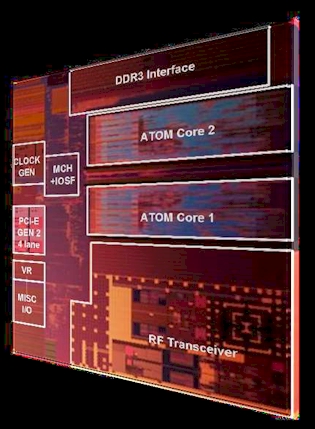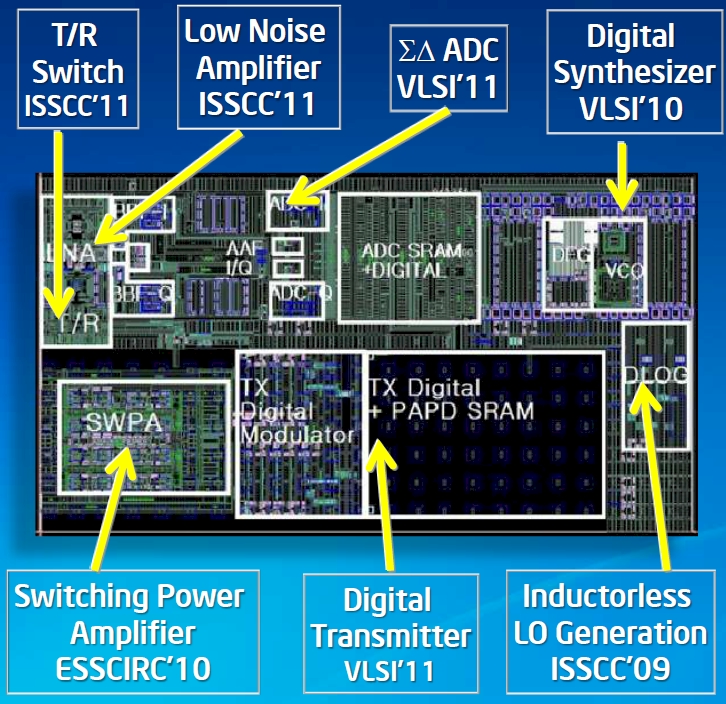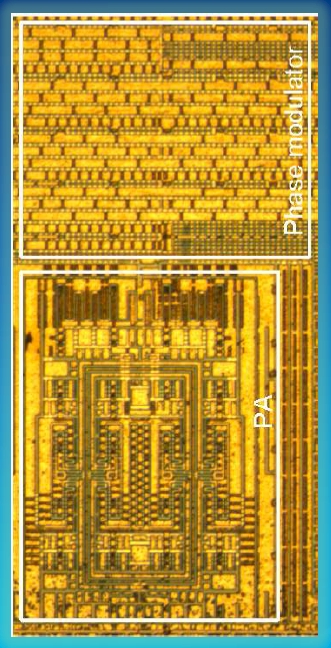This article is more than 1 year old
Intel shows off near threshold voltage chip wizardry
Full digital radio integration with Atom, too
What's the frequency, Kenneth?
Intel is no stranger to wired and wireless communications, and the lab boffins have spent the past several years "rethinking radio as a compute problem," as Rattner put it on the call.
Conventional radio circuits are analog, not digital in design, even if they are put on a CPU chip or next to it on adjacent chipsets. The problem with this is that all of the CMOS goodies that Intel cooks up for digital circuits for dynamic scaling and power efficiency can't be applied to these analog circuits.
As you can see from the chart below, Intel has been not-so-quietly assembling digital RF circuits, with the eventual goal of integrating them onto the same slice of silicon as the CPU:
"We're getting pretty pretty close to having the complete kit to building these radios," said Rattner, conceding that baseband parts have been digitized for some time, but that RF parts are a bit trickier.
So Intel has cooked up a full-digital RF transmitter, implemented in its 32 nanometer processes. This transmitter is a 20dBm, 2.4GHz digital outphasing transmitter aimed at wireless LAN applications.
This circuit is compliant with WiFi 802.11g/n standards and Intel says that it has a ratio of power consumed per transmitted data that is "better than start of the art." Intel says that it will do even better when the RF transmitter is shrunk using the 22 nanometer Tri-Gate processes. Intel says that this is the first demonstration of a digital phase modulator architecture that delivers full Wi-Fi bandwidth, by the way.
To push the envelope a little bit further and test the manufacturing issues associated with integrating digital RF circuits onto CPUs, Intel Labs did an experimental integration of a dual-core Atom processor in 32 nanometers that also incorporates a Wi-Fi RF transceiver on the same die.
This chip, code-named "Rosepoint," is not a future product but a demonstration of the technology from Intel Labs that the product people could eventually commercialize.

Two Atoms and a WiFi RF transceiver, all in one
The point of the Rosepoint project was to demonstrate that you could put a radio operating at 2.5GHz and two Atom cores running at slightly less than 2GHz – effectively in the same range – and get them to run alongside each other without massive interference.
Rattner did not get into the specifics of how this was done, but Intel's chip boffins had to come up with some high resistivity substrates and make substantial changes to the 32 nanometer manufacturing processes to keep the radio and cores from interfering with each other during their operation.
"This gives us great confidence that we will be able to build true SoCs that have radio and compute on the chip," said Rattner. It will probably take until the middle of the decade for this to be commercialized, he said, adding that Intel embarked on this journey starting in 2003 when Pat Gelsinger was CTO and that it has taken longer to get here than either he or Gelsinger expected. ®


